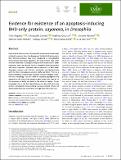| dc.contributor.author | Ikegawa, Yuko | |
| dc.contributor.author | Combet, Christophe | |
| dc.contributor.author | Groussin, Mathieu | |
| dc.contributor.author | Navratil, Vincent | |
| dc.contributor.author | Safar‐Remali, Sabrina | |
| dc.contributor.author | Shiota, Takuya | |
| dc.contributor.author | Aouacheria, Abdel | |
| dc.contributor.author | Yoo, Sa K. | |
| dc.date.accessioned | 2024-11-05T19:51:39Z | |
| dc.date.available | 2024-11-05T19:51:39Z | |
| dc.date.issued | 2023-02-02 | |
| dc.identifier.uri | https://hdl.handle.net/1721.1/157496 | |
| dc.description.abstract | Cells need to sense stresses to initiate the execution of the dormant cell death program. Since the discovery of the first BH3‐only protein Bad, BH3‐only proteins have been recognized as indispensable stress sensors that induce apoptosis. BH3‐only proteins have so far not been identified in Drosophila despite their importance in other organisms. Here, we identify the first Drosophila BH3‐only protein and name it sayonara. Sayonara induces apoptosis in a BH3 motif‐dependent manner and interacts genetically and biochemically with the BCL‐2 homologous proteins, Buffy and Debcl. There is a positive feedback loop between Sayonara‐mediated caspase activation and autophagy. The BH3 motif of sayonara phylogenetically appeared at the time of the ancestral gene duplication that led to the formation of Buffy and Debcl in the dipteran lineage. To our knowledge, this is the first identification of a bona fide BH3‐only protein in Drosophila, thus providing a unique example of how cell death mechanisms can evolve both through time and across taxa. | en_US |
| dc.publisher | Nature Publishing Group UK | en_US |
| dc.relation.isversionof | https://doi.org/10.15252/embj.2021110454 | en_US |
| dc.rights | Creative Commons Attribution | en_US |
| dc.rights.uri | https://creativecommons.org/licenses/by/4.0/ | en_US |
| dc.source | Nature Publishing Group UK | en_US |
| dc.title | Evidence for existence of an apoptosis‐inducing BH3‐only protein, sayonara, in Drosophila | en_US |
| dc.type | Article | en_US |
| dc.identifier.citation | The EMBO Journal. 2023 Feb 02;42(8):EMBJ2021110454 | en_US |
| dc.contributor.department | Massachusetts Institute of Technology. Department of Biological Engineering | en_US |
| dc.relation.journal | The EMBO Journal | en_US |
| dc.eprint.version | Final published version | en_US |
| dc.type.uri | http://purl.org/eprint/type/JournalArticle | en_US |
| eprint.status | http://purl.org/eprint/status/PeerReviewed | en_US |
| dc.date.updated | 2024-10-27T17:20:39Z | |
| dc.language.rfc3066 | en | |
| dc.rights.holder | The Author(s) | |
| dspace.date.submission | 2024-10-27T17:20:39Z | |
| mit.journal.volume | 42 | en_US |
| mit.journal.issue | 8 | en_US |
| mit.license | PUBLISHER_CC | |
| mit.metadata.status | Authority Work and Publication Information Needed | en_US |
